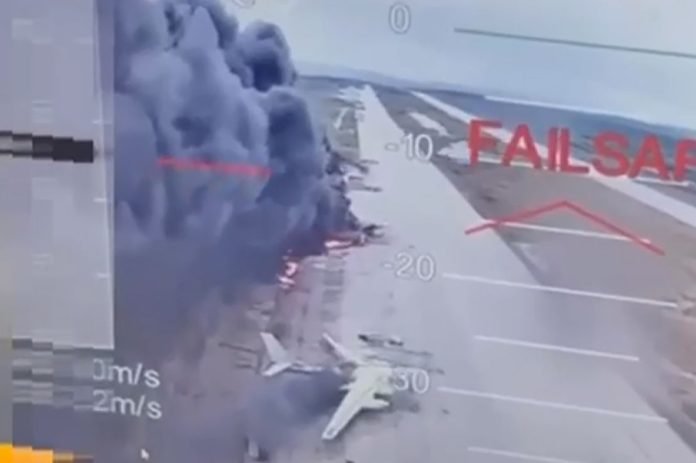Tel Aviv: The attack on June 1 performed by Ukraine using drones to destroy Russian aircraft in airbases is the ultimate proof to the major role of drones in warfare.
Israeli experts say that the wide use of this weapon and new development efforts will have a massive effect on the way military conflicts will look in the future.
The recent major attack performed by Ukraine on targets in Russia, according to the experts, is the utmost proof of the fast developing change.
“Even without an effective air force countries can gain massive presence in war arenas,” one of the sources said.
On June 1 Ukraine conducted a large-scale and simultaneous series of drone strikes against multiple airbases in Russia.
According to a report in the website of Institute for the Study of War Sources within Ukraine’s Security Service (SBU), the SBU conducted widespread first-person view (FPV) drone strikes that struck four airbases in Russia.
The SBU sources reported that Ukrainian forces struck Belaya Airbase in Irkutsk Oblast; Olenya Airbase in Murmansk Oblast; Dyagilevo Airbase in Ryazan Oblast; and Ivanovo Airbase in Ivanovo Oblast. The SBU sources confirmed that Ukrainian drone operators struck 41 Russian strategic bombers, including A-50 long-range radar detection aircraft and Tu-95 and Tu-22M3 strategic bombers – fixed-wing aircraft that Russia uses to detect Ukrainian air defences and launch cruise missiles against Ukraine.
The SBU reported that the operation inflicted roughly $7 billion worth of damage on Russia. The SBU sources confirmed that the SBU facilitated drone strikes by transporting the FPV drones to Russia at an unspecified time; storing the FPV drones in trucks carrying cargo units with retractable roofs; parking the trucks near the Russian air bases; and remotely opening the truck roofs and launching the FPVs.
Ukrainian President Volodymyr Zelensky confirmed that the operation used 117 drones and destroyed 34 percent of Russia’s strategic cruise missile carriers. Zelensky stated that Ukrainian authorities withdrew the people who “assisted” Ukraine with the operation from Russia before the operation.
The Russian Ministry of Defence (MoD) claimed that Ukrainian forces conducted FPV drone strikes against airbases in Irkutsk, and Murmansk oblasts, causing several aircraft to catch fire. The Russian MoD claimed that Russian forces repelled all strikes against airbases in Ivanovo, Ryazan, and Amur Oblasts. Russian opposition outlet Mediazona reported that Ukrainian authorities planned to conduct FPV drone strikes against an airbase in Amur Oblast, and Russian sources claimed that a truck carrying FPV drones near the Ukrainika Airbase in Amur Oblast caught fire before Ukrainian forces could launch the drones.
According to the report written by Olivia Gibson, Anna Harvey, Daria Novikov, Christina Harward, and Kateryna Stepanenko, the SBU was reportedly able to launch the FPV drones close to the targeted Russian airbases, which likely enabled the FPV drones to evade Russian electronic warfare (EW) systems and deny Russian air defenders enough time to detect the drones.
The SBU innovative use of semi-trucks to launch the FPV drones directly in Russian territory enabled Ukrainian drone operators to strike targets deep in Russia’s rear and conduct the first drone strike during the war against a target in Siberia. The SBU’s tactics to use FPV drones and not aircraft-type long-range drones also allowed drone operators to maintain operational surprise to inflict maximum damage and minimise Russia’s response window.
According to the report, Ukraine’s June 1 operation targeted aircraft that Russia uses to launch cruise missiles against Ukraine and airborne early warning and control (AEW&C) systems that Russia uses to identify Ukrainian air defence systems and coordinate Russian fighter jet targeting.
Russia regularly deploys Tu-95 and Tu-22M3 to launch Kh-101/Kh-555 and Kh-59/69 cruise missiles against Ukraine. The downing of Russian A-50 aircraft has temporarily constrained Russian aviation activities over Ukraine. The June 1 Ukrainian drone operation will force Russian officials to consider redistributing Russia’s air defence systems to cover a much wider range of territory.
First person view (FPV) technology allows operators to control drones or other remote-controlled vehicles by viewing a real-time video feed from an onboard camera, as if they were sitting inside the vehicle themselves. This immersive experience is achieved by transmitting video from the drone to a display device—such as FPV goggles, a monitor, or a smartphone—giving the pilot a direct, live perspective from the drone’s position.
An FPV has a camera mounted on the drone and captures real-time video from the vehicle’s perspective. It is also equipped with a video transmitter that sends the video feed wirelessly from the camera to the operator’s receiver.
A special antenna facilitates reliable transmission and reception of the video signal between the drone and the ground station.
A video receiver receives the transmitted video feed and delivers it to the display device. The FPV operator uses special goggles, monitors, or smartphones that show the live video feed to the operator. A separate radio controller is used to manoeuvre the drone.
-The writer is an Israel-based freelance journalist. The views expressed are of the writer and do not necessarily reflect the views of Raksha Anirveda



